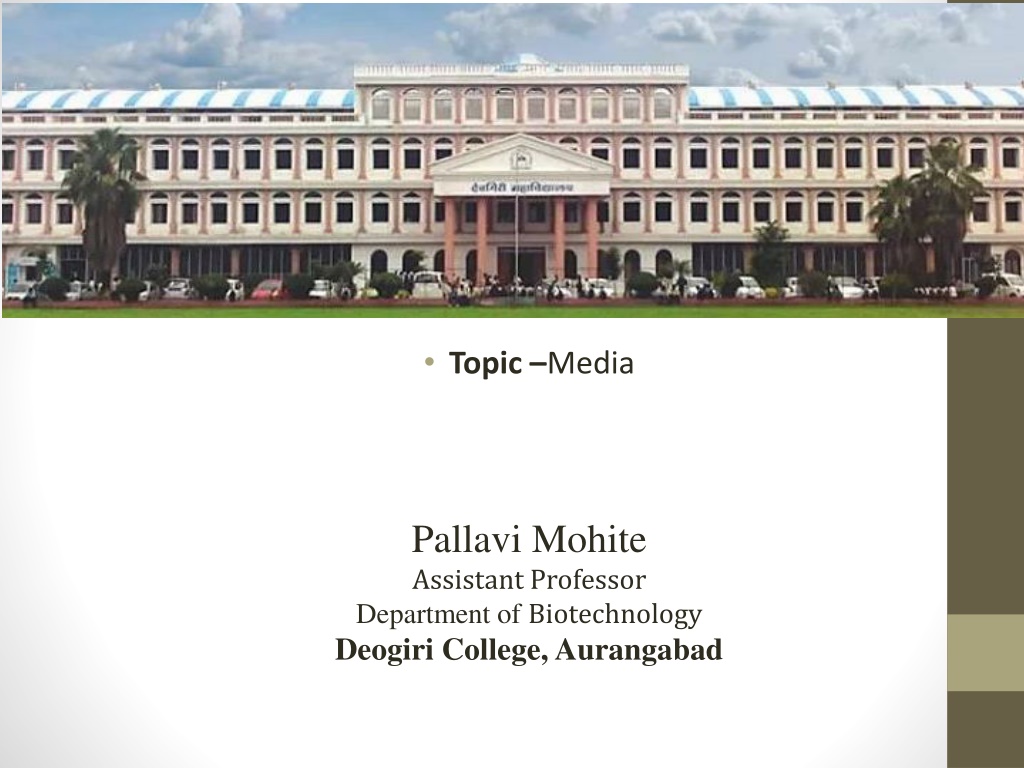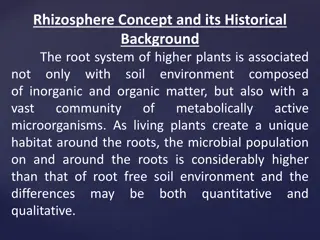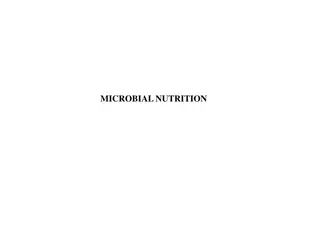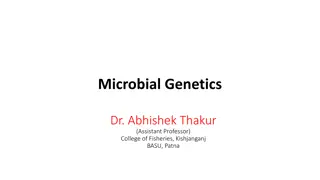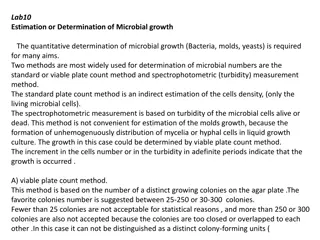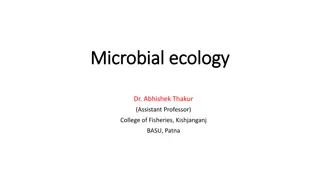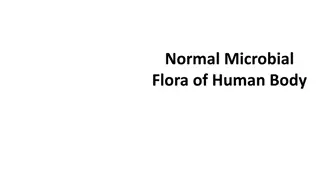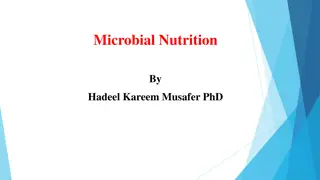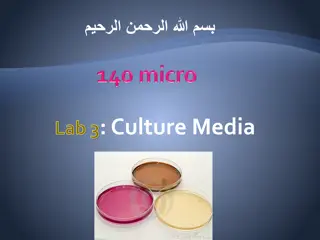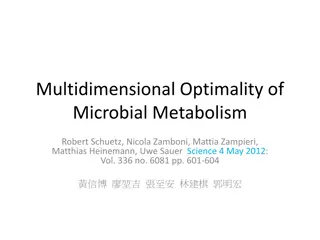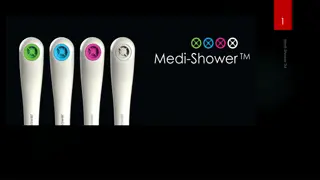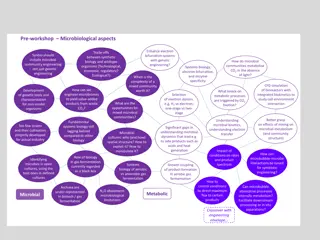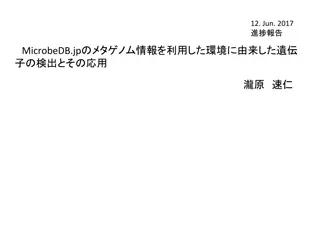Special Microbial Media Types and Examples
Special microbial media play a crucial role in microbiology for selective growth, inhibition, and differentiation of microorganisms. Explore various types like selective media, enrichment media, transport media, and more. Discover examples such as Mannitol Salt Agar (MSA) and MacConkey Agar, along with their applications and principles. Enhance your understanding of microbial culture techniques with these specialized media formulations.
Download Presentation

Please find below an Image/Link to download the presentation.
The content on the website is provided AS IS for your information and personal use only. It may not be sold, licensed, or shared on other websites without obtaining consent from the author.If you encounter any issues during the download, it is possible that the publisher has removed the file from their server.
You are allowed to download the files provided on this website for personal or commercial use, subject to the condition that they are used lawfully. All files are the property of their respective owners.
The content on the website is provided AS IS for your information and personal use only. It may not be sold, licensed, or shared on other websites without obtaining consent from the author.
E N D
Presentation Transcript
Topic Media Presented by Pallavi Mohite Assistant Professor Department of Biotechnology Deogiri College, Aurangabad
Media Class M.Sc. Biotech Pallavi Mohite Asst. Prof. DCA
Special microbial media. Selective media Indicator or Differential media Enriched media Enrichment media Microbiological assay media Transport media
Selective media Selective media allow certain types of organisms to grow, and inhibit the growth of other organisms. The selectivity is accomplished in several ways. For example, organisms that can utilize a given sugar are easily screened by making that sugar the only carbon source in the medium. On the other hand, selective inhibition of some types of microorganisms can be achieved by adding dyes, antibiotics, salts or specific inhibitors which affect the metabolism or enzyme systems of the organisms.
MANNITOL SALT AGAR (MSA) Mannitol salt agar is a selective medium used for the isolation of pathogenic staphylococci. The medium contains mannitol, a phenol red indicator, and 7.5% sodium chloride. The high salt concentration inhibits the growth of most bacteria other than staphylococci. On MSA, pathogenic Staphylococcus aureus produces small colonies surrounded by yellow zones. The reason for this change in color is that S. aureus ferments the mannitol, producing an acid, which, in turn, changes the indicator from red to yellow. The growth of other types of bacteria is generally inhibited.
MacConkeyAgar MacConkey agar (MAC) was the first solid differential media to be formulated which was developed at 20th century by Alfred Theodore MacConkey. MacConkey agar is a selective and differential media used for the isolation and differentiation of non-fastidious gram-negative rods, particularly members of the family Enterobacteriaceae and the genus Pseudomonas. Principle of MacConkey Agar MacConkey agar is used for the isolation of gram-negative enteric bacteria and the differentiation of lactose fermenting from lactose non- fermenting gram-negative bacteria. Pancreatic digest of gelatin and peptones (meat and casein) provide the essential nutrients, vitamins and nitrogenous factors required for growth of microorganisms. Lactose monohydrate is the fermentable source of carbohydrate. The selective action of this medium is attributed to crystal violet and bile salts, which are inhibitory to most species of gram-positive bacteria. Sodium chloride maintains medium. Neutral red is a pH indicator that turns red at a pH below 6.8 and is colorless at any pH greater than 6.8. Agar is the solidifying agent. the osmotic balance in the
DIFFERENTIAL MEDIA Differential media are used to differentiate closely related organisms or groups of organisms. Owing to the presence of certain dyes or chemicals in the media, the organisms will produce characteristic changes or growth patterns that are used for identification or differentiation. A variety of selective and differential media are used in medical, diagnostic and water pollution laboratories, and in food and dairy laboratories. Most common selective and differential media are described below and will be used in the laboratory exercise.
EOSIN METHYLENE BLUE AGAR (EMB agar) Eosin methylene blue agar is a differential medium used for the detection and isolation of Gram-negative intestinal pathogens. A combination of eosin and methylene blue is used as an indicator and allows differentiation between organisms that ferment lactose and those that do not. Saccharose is also included in the medium because certain members of the Enterobacteria or coliform group ferment saccharose more readily than they ferment lactose. In addition, methylene blue acts as an inhibitor to Gram-positive organisms. Colonies of E. coli normally have a dark center and a greenish metallic sheen, whereas the pinkish colonies of Enterobacter aerogenes are usually mucoid and much larger than colonies of E. coli. Other organisms, such as Salmonella (one of the causative agents of food poisoning), do not ferment lactose or saccharose and produce colonies that are noncolored.
Enriched medium (added growth factors) In some cases, it is necessary to formulate an enriched medium. Such a medium provides specific nutrients that encourage selected species of microorganisms to flourish in a mixed sample. Addition of extra nutrients in the form of blood, serum, egg yolk, etc, to basal medium makes enriched medium. Enriched media are used to grow nutritionally extracting (fastidious) bacteria. Blood agar, chocolate agar, Loeffler s serum slope, etc are a few examples of enriched media. Blood agar is prepared by adding 5-10% (by volume) blood to a blood agar base. Chocolate agar is also known as heated blood agar or lysed blood agar.
Blood agar Blood agar, like most other nutritional media, has one or more protein sources, salt, and beef extract for vitamins and minerals. Besides these components, 5% defibrinated mammalian blood is also added to the medium. Blood agar is an enriched nutritious medium that supports the growth of fastidious organisms by supplementing it with blood or as a general medium without the blood. The blood added to the base provides more nutrition to the medium by providing additional growth factors required for these fastidious organisms. The blood also aids in visualizing hemolytic reactions of different bacteria. The hemolytic reactions, however, depend on the type of animal blood used. Sheep blood is mostly used for Group A Streptococci as it provides the best results, but it fails to support the growth of Haemophilus haemolyticus. It is because sheep blood is deficient in pyridine nucleotides. The growth and hemolysis of H. haemolyticus are best with horse blood, and the pattern of hemolysis might even mimic Streptococcus pyogenes on sheep blood.
Blood Agar andHemolysis Hemolysis is the lysis of red blood cells in the blood due to the extracellular enzymes produced by certain bacterial species. The extracellular enzymes produced by these bacteria are called hemolysins which radially diffuse outwards from the colonies, causing complete or partial lysis of the red blood cells. 1. Alpha hemolysis Alpha hemolysis is defined by a greenish-grey or brownish discoloration around the colony as a result of the partial lysis of the red blood cells. During -hemolysis, H2O2 produced by the bacteria causes hemoglobin present in the RBC of the medium is converted into methemoglobin. Some of the -hemolytic species are a part of the human normal flora, but some species like Streptococcus pneumonia causes pneumonia and other such severe infections.
2. Beta hemolysis Beta hemolysis is defined by a clear zone of hemolysis under and around the colonies when grown on blood agar. The clear zone appears as a result of the complete lysis of the red blood cells present in the medium, causing denaturation of hemoglobin to form colorless products. -hemolytic bacteria include the Group A streptococci like S. pyogenes and S. agalactiae, both of which are associated with severe infections in humans. 3. Gamma hemolysis Gamma hemolysis is also called non-hemolysis as no lysis of red blood cells occurs. As a result, no change of coloration or no zone of hemolysis os observed under or around the colonies. Species like Neisseria meningiditis are non-hemolytic or gamma-hemolytic.
